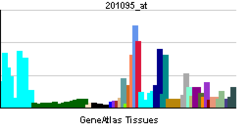- DAP (gene)
-
Death-associated protein Identifiers Symbols DAP; MGC99796 External IDs OMIM: 600954 MGI: 1918190 HomoloGene: 3235 GeneCards: DAP Gene RNA expression pattern 
More reference expression data Orthologs Species Human Mouse Entrez 1611 223453 Ensembl ENSG00000112977 ENSMUSG00000039168 UniProt P51397 Q3U706 RefSeq (mRNA) NM_004394 NM_146057.3 RefSeq (protein) NP_004385 NP_666169.1 Location (UCSC) Chr 5:
10.68 – 10.76 MbChr 15:
31.15 – 31.2 MbPubMed search [1] [2] Death-associated protein 1 is a protein that in humans is encoded by the DAP gene.[1][2][3]
DAP gene encodes a basic, proline-rich, 15-kD protein. Death-associated protein acts as a positive mediator of programmed cell death that is induced by interferon-gamma.[3]
References
- ^ Feinstein E, Druck T, Kastury K, Berissi H, Goodart SA, Overhauser J, Kimchi A, Huebner K (Feb 1996). "Assignment of DAP1 and DAPK--genes that positively mediate programmed cell death triggered by IFN-gamma--to chromosome regions 5p12.2 and 9q34.1, respectively". Genomics 29 (1): 305–7. doi:10.1006/geno.1995.1255. PMID 8530096.
- ^ Deiss LP, Feinstein E, Berissi H, Cohen O, Kimchi A (Feb 1995). "Identification of a novel serine/threonine kinase and a novel 15-kD protein as potential mediators of the gamma interferon-induced cell death". Genes Dev 9 (1): 15–30. doi:10.1101/gad.9.1.15. PMID 7828849.
- ^ a b "Entrez Gene: DAP death-associated protein". http://www.ncbi.nlm.nih.gov/sites/entrez?Db=gene&Cmd=ShowDetailView&TermToSearch=1611.
Further reading
- Levy-Strumpf N, Kimchi A (1999). "Death associated proteins (DAPs): from gene identification to the analysis of their apoptotic and tumor suppressive functions". Oncogene 17 (25): 3331–40. doi:10.1038/sj.onc.1202588. PMID 9916995.
- Olsen JV, Blagoev B, Gnad F et al. (2006). "Global, in vivo, and site-specific phosphorylation dynamics in signaling networks". Cell 127 (3): 635–48. doi:10.1016/j.cell.2006.09.026. PMID 17081983.
- Zougman A, Wiśniewski JR (2006). "Beyond linker histones and high mobility group proteins: global profiling of perchloric acid soluble proteins". J. Proteome Res. 5 (4): 925–34. doi:10.1021/pr050415p. PMID 16602700.
- Gerhard DS, Wagner L, Feingold EA et al. (2004). "The Status, Quality, and Expansion of the NIH Full-Length cDNA Project: The Mammalian Gene Collection (MGC)". Genome Res. 14 (10B): 2121–7. doi:10.1101/gr.2596504. PMC 528928. PMID 15489334. http://www.pubmedcentral.nih.gov/articlerender.fcgi?tool=pmcentrez&artid=528928.
- Suzuki Y, Yamashita R, Shirota M et al. (2004). "Sequence Comparison of Human and Mouse Genes Reveals a Homologous Block Structure in the Promoter Regions". Genome Res. 14 (9): 1711–8. doi:10.1101/gr.2435604. PMC 515316. PMID 15342556. http://www.pubmedcentral.nih.gov/articlerender.fcgi?tool=pmcentrez&artid=515316.
- Strausberg RL, Feingold EA, Grouse LH et al. (2003). "Generation and initial analysis of more than 15,000 full-length human and mouse cDNA sequences". Proc. Natl. Acad. Sci. U.S.A. 99 (26): 16899–903. doi:10.1073/pnas.242603899. PMC 139241. PMID 12477932. http://www.pubmedcentral.nih.gov/articlerender.fcgi?tool=pmcentrez&artid=139241.
Categories:- Human proteins
- Chromosome 5 gene stubs
Wikimedia Foundation. 2010.
